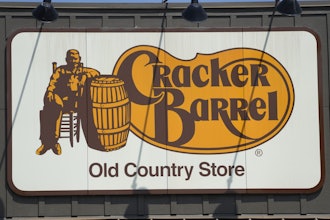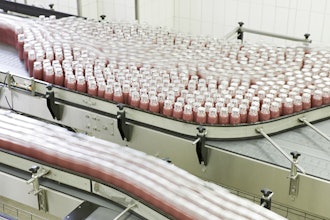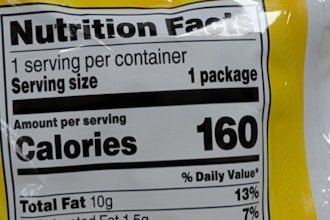Labeling is complex, and today’s food and beverage professionals are faced with a range of requirements that further complicate the process. This leaves many companies to accept this process as the cost of doing business. But it doesn’t have to be this way. Labeling can make a huge difference, enabling decision makers in supply chain, logistics, corporate compliance, IT, and other stakeholders to not just overcome challenges, but provide their company with a distinct competitive advantage.
By leveraging and applying current GS1 standards with a proven Enterprise Labeling Solution, you can keep up with mounting food safety regulations — like FSMA and EU1169 — as well as ever-changing customer label demands.
How Can Labeling Improve Your Ability to Comply with FSMA, EU1169 and other Regulations?
From a regulatory standpoint, there’s more focus now on food & beverage than ever before. And it affects everyone — from growers and manufacturers to 3PLs, co-packers, and distributors—right down to the grocers and consumers themselves. The FDA’s Food Safety and Modernization Act (FSMA) is the hot button now, aimed at preventing food contamination across every step of the supply chain, including use of imports and exports across international boundaries. FSMA also gives the FDA authority to order a mandatory recall of product.
The key to compliance with FSMA, Europe’s EU1169, the impending GMO labeling law, and other regulations is to adopt labeling standards like GS1 GTINs and barcodes, and manage them through a centralized labeling process. It is shocking how many large, successful manufacturers still rely on separate, siloed labeling solutions at individual sites and plants. And often they’re using software products that can’t even talk to each other. This is a recipe for disaster — especially for regulatory and compliance teams that need visibility into the labels to make sure they’re marked correctly for allergens, GMO ingredients, or country-specific regulations.
A single, standardized labeling solution, implemented and supported across an organization brings labeling under one platform. And when it’s tightly integrated with existing enterprise systems, you not only improve label accuracy, but you have a central “go-to” source to monitor, manage and control all the labeling — on the product itself, the carton, the pallet — from manufacturing to transport to the grocer’s shelves. Best of all, when regulations do change (as they always do!), you’ve simplified the process and narrowed it down to one solution where you can update and apply appropriate label changes.
What Advancements in Labeling Help Avoid Risk When It Comes To Food Safety Issues?
As you know, mislabeled product can lead to penalties and returned product at best — catastrophic health concerns at worst. None of which are good for business. And yet if you are using labeling solutions that replicate data in a separate database or repository, you are greatly increasing your odds for error. Here’s where that tight integration with systems like SAP, Oracle, Microsoft, Epicor, Infor, and other ERP applications really helps eliminate risk.
Simply put, it makes little sense for your labeling solution to take on data creation and management. That’s why you’ve invested in those other systems. Instead, labeling should integrate with your existing data sources — those critical records of truth — to all but guarantee the most current information is on the label every time. Obviously, your ERP systems contain much of the data that needs to go on the label, but we’ve also had instances where we’ve tied our labeling solution into manufacturing execution systems (MES) and warehouse management systems (WMS), even legal and regulatory databases managed within larger food and beverage companies.
It’s what we mean by data-driven labeling, and it’s essential to assuring that the right information is on the right labels every time.
How Can Today’s Labeling Solutions Help Streamline A Product Recall?
Unfortunately, even with best practices in place, there are times when companies need to recall product due to contamination, expired freshness dates, or other health concerns. Enterprise labeling solutions can greatly reduce the impact by providing a centralized platform to quickly and accurately track and trace product across your extended supply chain. Authorized users can rely on the system to search and source label data and create customized reports to help pinpoint the location of product — in transit, at the distributor warehouse, on the retailer’s shelves, wherever—for faster recovery.
Recently a manufacturer of process foods came to us after they experienced a recall when a supplier provided contaminated meat. Without a standardized process in place, they scrambled to track down the affected product — putting production on hold and leaving their customers at risk, not to mention their reputation. After several days, they were able to remedy the situation and thankfully no one got sick, but the lesson was learned. We have since provided them with a labeling solution that provides the enterprise-wide visibility to act swiftly and efficiently in the event of another recall.
In fact, as more and more food & beverage companies participate in “mock recalls” to better prepare their teams for such a scenario, they’re asking us how enterprise labeling software can play a key role to significantly improve response and recovery times.
What Can Labeling Do To Help With Overall Cost Reduction In The Food Supply Chain?
A basic business principle applies here: If you can move product faster and more efficiently, you will reduce costs—not to mention increase productivity, extend shelf life, improve customer satisfaction, and so on. But many food and beverage companies aren’t paying attention to areas within the supply chain where delays and mistakes happen at an alarming rate. Labeling is often an afterthought, but what if a customer wants a recently rebranded logo on a label? Or what if a supplier delivers ingredients with the wrong label? To address these specific issues, you may lose several hours or, more likely, several days.
Now multiply this delay by the number of unique labeling requirements your company deals with on a regular basis. Labeling intersects several places within your supply chain where you can uncover hidden costs — or, if addressed properly, hidden value.
In another example, we worked with one of the world’s leading food and beverage companies that was struggling with customer-specific labeling. More and more customers had special requests for their labels, be it branding, language, or even graphics. They also had to deal with changing regulations in China that had to be applied to labels within 30 days. For a multi-billion-dollar company with 20+ plants worldwide, changes like this often took weeks or even months. But because we were able to tightly integrate labeling within their existing SAP environment and enable business rules that let certain users make formatting changes on the fly, the company was able to keep up with these demands — saving an estimated $600K in yearly fines.
Fact is, many customers are now able to greatly reduce or even eliminate compliance fines as part of their annual budget. When you have the labeling solution in place to respond faster to whatever changes come your way, why budget for the cost or penalty of not being able to make changes?
How Can Labeling Help Companies Save When Working With Suppliers and Other Partners?
Just as you can leverage an enterprise-wide solution to create, manage and share labels within your organization, there are added cost-savings when you collaborate with suppliers, co-packers, 3PLs and other partners. If you’re like most food & beverage manufacturers, you rely on suppliers to deliver goods or ingredients in a timely manner, but you experience costly hold ups in receiving as containers often need to be re-labeled before moving on in the production line. You could send suppliers your own pre-printed labels, but that has its own drawbacks as you’re beholden to their process of storing and applying labels.
Here’s an example: we recently visited the plant of a global ingredients manufacturer and distributor and noticed they had stacks and stacks of supplier goods in their receiving area. This was additional inventory that was waiting to be relabeled. Part of the problem was a disconnect between corporate and operations where there was no enterprise visibility or ownership of the labeling process. They told us they stored two weeks’ worth of safety stock to account for relabeling, which took about 80 man hours every month. They have 12 plants following a similar process. Quickly do the math and you’re looking at about $900K annually wasted on labor, materials, and inventory management costs — not to mention the loss in workforce productivity that could’ve been used elsewhere.
An enterprise labeling solution eliminates this problem by letting you share label templates with suppliers and other partners so incoming materials are labeled and formatted the way you want them. Shipments quickly move on to the next step of the process. We’ve seen some companies save upwards of millions of dollars in relabeling costs when switching over to an enterprise labeling solution.
How Can Labeling Help Food Manufacturers Grow and Expand Their Business?
With competition as fierce as ever, food & beverage companies are always looking to improve efficiency and grow their business where it makes sense. Expansion can occur as a result of mergers and acquisitions too, as companies extend their global footprint for supply chain advantages. As such, companies need to figure out how to bring on new products and/or new divisions in the most efficient manner possible.
In all these instances, it’s important that you have a labeling solution that can seamlessly adapt and grow with you. Whether it’s being able to integrate with new or acquired data systems or leverage robust design capabilities to create and modify templates or use built-in business logic to automate and manage labeling at recently added remote locations, an enterprise labeling solution should enhance or promote growth — not slow it down. Certainly, any kind of technology integration, particularly at the enterprise level, requires careful planning and execution. But when done correctly, it leads to more accurate, agile, and flexible labeling across the extended organization.
And to that point, it’s really key that you partner with a company that understands these and other challenges, and has the experience to deliver the solution right for you. Every situation is different — from dealing with the sudden need to comply with EU1169 or GMO labeling regulations to managing a complex number of import/export partners to speeding up the delivery of perishable goods in a new market — and you want to make sure you get it right the first time, and for the life of your labeling solution.























